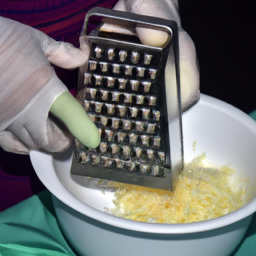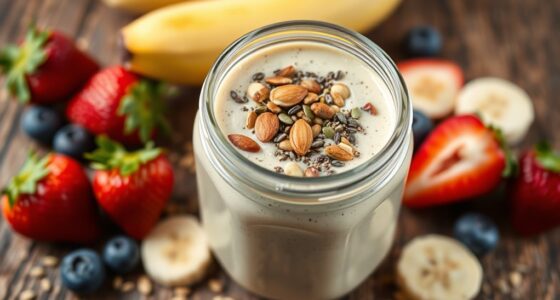I once thought it was unfeasible to produce orange juice without the aid of a juicer. I was under the impression that the sole method to savor a glass of fresh orange juice was by acquiring a costly juicer. Nevertheless, through some investigation and trial, I came to realize that preparing tasty orange juice without a juicer is surprisingly easy.
In this article, I’ll be sharing my step-by-step process for making orange juice without a juicer. All you need is a few oranges, a knife, a strainer, and a container to mix and chill the juice.
Not only is it easy and affordable, but making your own orange juice has numerous health benefits compared to store-bought juice. So, grab some oranges and let’s get squeezing!
Key Takeaways
- Choose heavy oranges with smooth, firm skin
- Alternative squeezing methods: citrus reamer, fork, wooden spoon, hands
- Strain the juice with a fine mesh strainer or cheesecloth to remove pulp and seeds
- Options for sweetening: honey, stevia, sugar
Gather Your Materials
Gotta gather up your materials before you can start squeezing those oranges! First things first, you’ll need to choose the right oranges. Look for oranges that are heavy for their size and have a smooth, firm skin. Navel oranges are a good choice because they’re usually seedless and easy to peel. Valencia oranges are also great for juicing because they have a high juice content.
Once you have your oranges, you’ll need to use alternative squeezing methods. If you have a citrus reamer, it’s a great tool for juicing oranges. You can also use a fork or a wooden spoon to extract the juice. Simply cut the oranges in half and use the tool to squeeze out the juice. If you don’t have any of these tools, you can always use your hands to squeeze the juice out. Just make sure to remove any seeds that may have fallen in.
Now that you have your materials, it’s time to cut and squeeze the oranges.
Cut and Squeeze the Oranges
First, you’ll need to grab a sharp knife and a bowl to start cutting and squeezing those juicy fruits. Begin by washing the oranges thoroughly under running water to remove any dirt or bacteria that may be present on the surface. Once you’ve cleaned them, use a sharp knife to cut each orange in half, and then place the halves into the bowl.
Next, use your hands to squeeze each orange half firmly, extracting as much juice as possible. There are a few hand squeezing techniques you can use to get the most juice out of your oranges. You can roll them on a hard surface before cutting them, use a citrus juicer or reamer, or simply use your hands to apply pressure while squeezing.
If you want to add a little extra flavor to your orange juice, try experimenting with different varieties of oranges. Blood oranges, for example, have a slightly tart and tangy flavor that can add a unique twist to your juice. Valencia oranges, on the other hand, have a sweeter taste that can be perfect for those who prefer a milder flavor. Additionally, you can add other fruits like lemons or strawberries for additional flavor.
Once you’ve finished squeezing all of your oranges, you’re ready to move on to the next step and strain the juice. To strain the juice, you’ll need a fine mesh strainer or cheesecloth. Simply pour the juice through the strainer or cheesecloth into a pitcher, removing any pulp or seeds that may be present. If you prefer a pulpier juice, you can skip this step and leave the pulp in.
Now that you’ve strained your juice, it’s ready to be served over ice or stored in the refrigerator for later.
Strain the Juice
After squeezing the oranges, it’s time to filter out any remaining pulp or seeds by straining the juice through a fine mesh strainer or cheesecloth, creating a smooth and pure liquid sunshine. Straining is a crucial step if you want a juice with a consistent texture. The last thing you want is a glass of orange juice with bits of pulp or seeds floating around.
Using a fine mesh strainer or cheesecloth will ensure that all the pulp and seeds are removed, leaving you with a smooth and silky juice. When it comes to straining methods, you have a few options. A fine mesh strainer is the easiest and most readily available option. Simply pour the juice through the strainer and use a spoon to press the pulp against the mesh, extracting as much juice as possible. Alternatively, you can use a cheesecloth. Place the cloth over a bowl and pour the juice into the cloth. Gather the corners of the cloth and twist it to squeeze out the juice.
Whatever method you choose, straining is a simple yet crucial step to achieve a smooth and consistent juice. Now that the juice is strained, it’s time to add sweetener (optional).
Add Sweetener (Optional)
If you’re looking for a sweeter flavor, you can choose to add a sweetener of your choice to the strained orange juice. However, it’s important to keep in mind that adding sweeteners can also add additional calories and sugar to your drink.
Here are some options for sweetening your orange juice, along with some health concerns to consider:
-
Honey: Honey is a natural sweetener that adds a touch of sweetness without overpowering the orange flavor. However, it’s still important to use honey in moderation, as it’s high in calories and sugar.
-
Stevia: Stevia is a zero-calorie sweetener that comes from a plant. It’s a good option for those looking to avoid added sugar, but some people may find that it has a slightly bitter aftertaste.
-
Sugar: While sugar is a common sweetener for orange juice, it’s important to remember that it adds a significant amount of calories and sugar to your drink. If you do choose to use sugar, try to use it sparingly.
After adding your chosen sweetener, mix the orange juice well and chill it in the refrigerator for a refreshing and healthy drink.
Mix and Chill
Now it’s time to mix your freshly squeezed orange juice with your chosen sweetener and chill it in the refrigerator for a refreshing and healthy drink that will quench your thirst and provide you with essential nutrients. The amount of sweetener you use will depend on your personal preference, but be careful not to add too much as it may overpower the natural sweetness of the oranges. You can choose to use honey, agave syrup, or sugar as your sweetener.
To add some flavor variations to your orange juice, you can also consider adding a pinch of salt or a few drops of vanilla extract. These simple additions can enhance the taste of your orange juice and give it a unique twist.
Once you have mixed in your sweetener and any additional flavorings, it’s time to chill your orange juice in the refrigerator for at least 30 minutes before serving. Not only will it taste better when it’s cold, but chilling your orange juice will also help to preserve its nutritional benefits.
Now that your orange juice is ready, it’s time to sit back, relax, and enjoy your refreshing and healthy drink. Whether you’re starting your day or need an afternoon pick-me-up, this homemade orange juice is the perfect way to quench your thirst and boost your immune system with essential vitamins and minerals.
Enjoy Your Fresh Orange Juice!
Sit back, relax, and savor the refreshing taste of your homemade orange juice, bursting with essential nutrients to keep you energized throughout the day.
Now that you’ve made a delicious batch of orange juice, it’s important to know how to store it properly. Here are some tips on juice storage:
- Store your juice in an airtight container in the refrigerator.
- Consume the juice within 24-48 hours to ensure maximum freshness and nutrient content.
- If you want to store your juice for a longer period, freeze it in an ice cube tray and use as needed.
When it’s time to serve your orange juice, there are many creative ways to enjoy it. Here are some serving suggestions:
- Serve chilled with ice cubes for a refreshing drink on a hot day.
- Mix with sparkling water or champagne for a fun and fizzy cocktail.
- Use as a base for smoothies or popsicles for a healthy and tasty treat.
With these tips, you can enjoy your homemade orange juice for days to come.
Now, let’s move on to some tips and tricks for best results.
Tips and Tricks for Best Results
Get the most out of your citrus fruits by using a hand-held citrus juicer. This tool can help you extract every last drop of juice from your oranges and leave the bitter pulp behind, resulting in a smoother and more consistent juice.
Make sure to choose the right oranges for juicing, as some varieties are sweeter and juicier than others. Valencia oranges are a popular choice for juicing because they’re juicy and have a slightly tart taste. Navel oranges are also a good choice as they’re seedless and have a sweet taste.
When juicing your oranges, it’s important to keep in mind that the consistency of the juice will depend on the amount of pulp you leave in. If you prefer a smoother juice, you can strain the pulp out using a fine mesh sieve or cheesecloth. On the other hand, if you prefer a pulpy juice, you can leave the pulp in.
Experiment with different consistencies until you find the one that you like best. With these tips and tricks, you can make delicious orange juice right in the comfort of your own home.
And now, let’s move on to the benefits of making your own orange juice.
Benefits of Making Your Own Orange Juice
You’ll feel healthier and more energized when you start incorporating freshly squeezed orange juice into your daily routine. Not only does it taste better than store-bought varieties, but it also has a plethora of health benefits.
For starters, orange juice is a great source of vitamin C, which helps boost your immune system and fight off infections. It also contains potassium, which can help regulate blood pressure, and folate, which is essential for healthy cell growth and development.
In terms of taste comparison, freshly squeezed orange juice simply can’t be beaten. It has a bright, tangy flavor that’s much more vibrant than anything you can buy in a carton. Plus, you can adjust the sweetness to your liking by choosing the right oranges and adding natural sweeteners like honey or agave.
All in all, making your own orange juice is an easy and delicious way to improve your health and well-being. When it comes to other citrus fruits to try, there are plenty of options to choose from. Grapefruit and lemon are both great choices, as they offer similar health benefits and can also be used in a variety of recipes. Additionally, lime juice is a fantastic addition to savory dishes like guacamole or fish tacos.
So why not expand your horizons and start experimenting with different citrus fruits today?
Other Citrus Fruits to Try
If you’re feeling adventurous, try incorporating other citrus varieties into your diet for a burst of new flavors and health benefits. While oranges are a great source of vitamin C, other citrus fruits also have their own unique nutritional advantages.
Here are five citrus fruits that you can try to add some variety to your juice-making routine:
-
Grapefruit: This tangy fruit is high in antioxidants and has been shown to aid in weight loss. Its bitter taste pairs well with sweeter fruits like oranges and pineapples.
-
Lemons: Known for their sour taste, lemons are a great source of vitamin C and have antibacterial properties. They can be a great addition to green juices or used to add a tangy kick to your orange juice.
-
Limes: Similar to lemons, limes are a great source of vitamin C and have a tart taste. They pair well with spicy flavors and can add a refreshing twist to your juice.
-
Tangerines: These small, sweet citrus fruits are packed with vitamin A and are great for juicing. They have a slightly sweeter taste than oranges and can add a fun twist to your juice.
-
Blood oranges: These oranges have a unique dark red flesh and a sweet-tart taste. They are high in vitamin C and antioxidants, and their beautiful color can add a pop of color to your juice.
By incorporating other citrus varieties into your juice-making routine, you can explore new flavor combinations and reap the nutritional benefits of a wider range of fruits. Don’t be afraid to experiment and try new things – you might just discover your new favorite juice blend!
Frequently Asked Questions
How long does homemade orange juice last in the fridge?
Homemade orange juice can last up to five days in the fridge if stored properly. It’s best to keep it in an airtight container to prevent oxidation. Avoid using preservatives and consume it as soon as possible for maximum freshness.
Can I use bottled orange juice to make this recipe?
Yes, you can use bottled orange juice to make orange juice. The pros are convenience and longer shelf life, but homemade orange juice may be healthier due to fewer additives.
Is it necessary to strain the juice or can I leave the pulp in?
Like a refreshing breeze on a hot day, leaving the pulp in my homemade orange juice is my preference. Not only does it add a pleasant texture, but it also provides additional nutritional benefits like fiber.
How many oranges do I need to make one glass of juice?
To make one glass of orange juice, I typically use 3-4 medium-sized oranges. The orange juice concentration and nutritional value of homemade orange juice is higher than store-bought varieties, making it a healthier choice.
Can I use a blender instead of a juicer to make orange juice?
Blender vs juicer: which is better for making orange juice? While a juicer yields more juice, a blender can also work. Tips for getting the most juice out of oranges include microwaving them for a few seconds and rolling them on a hard surface before squeezing.
Conclusion
Well, folks, that’s it! You now know how to make orange juice without a juicer. It’s a simple process that can be done in just a few minutes with the right materials and a little elbow grease.
By cutting and squeezing the oranges, straining the juice, adding sweetener (if desired), and mixing and chilling, you’ll have a delicious, refreshing drink that’s perfect for any time of day.
As the saying goes, ‘when life gives you oranges, make orange juice!’ And now, with this handy guide, you can do just that. Not only is homemade orange juice a tasty treat, but it also has numerous health benefits, such as being a good source of vitamin C and antioxidants. Plus, by making your own juice, you can avoid the added sugars and preservatives often found in store-bought varieties.
So why not branch out and try making juice from other citrus fruits, such as grapefruit or lemon? With a little experimentation, you might just discover your new favorite drink. Cheers to a healthier, tastier way to enjoy your daily dose of Vitamin C!
Ilana has been a vegan for over 10 years. She originally made the switch for health reasons, but soon found herself becoming more and more passionate about the ethical and environmental implications of a vegan lifestyle. Ilana is the author of The Graceful Kitchen, a blog all about veganism. She loves to cook up delicious and nutritious vegan meals, and share her recipes with others who are interested in leading a cruelty-free life. Ilana is also a strong advocate for using whole foods as the foundation of a healthy diet, and believes that going vegan is one of the best ways to achieve this.










